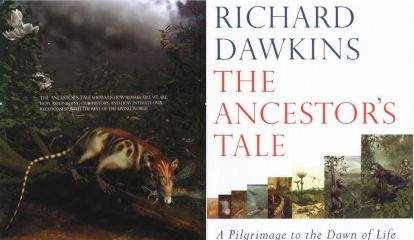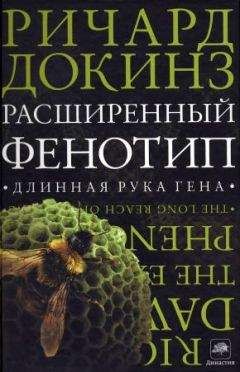Ричард Докинз - Рассказ предка. Путешествие к заре жизни.

Помощь проекту
Рассказ предка. Путешествие к заре жизни. читать книгу онлайн
Я подозреваю, что многие, кто называет себя верующими, согласились бы со мной. Для них я только процитировал бы любимое высказывание, которое я нечаянно услышал на научной конференции. Известный государственный деятель вел на эту тему длинный спор с коллегой. Когда препирательство закончилось, он подмигнул и сказал: «Вы знаете, мы действительно сошлись во мнениях. Только то, что Вы говорите – неправильно!»
Я чувствую, что вернулся из настоящего путешествия.
БИБЛИОГРАФИЯ
[1] ADAMS. D. (1987) Dirk Gently's Holistic Detective Agency. William Heinemann, London.
[2] ADAMS. D. & CARWARDINE. M. (1991) Last Oiance to See. Pan Books, London. 2nd edn.
[3] AGUINALDO. A. M. A., TURBEVILIE, J. M., LINFORD, L. S., et al. (1997) Evidence for a clade of nematodes, arthropods and other moulting animals. Nature 387: 489-493.
[4] AHLBERG, P. E. SI MILNER. A. R. (2000/1994) The origin and early diversification of tetrapods. In Shaking the Tree: Readings from Nature in the History of life (Gee, H.. ed.). University of Chicago Press, Chicago (Originally published Nature 368: 507-514).
[5] ALEXANDER, R. D., HOOGLAND. J. L.. HOWARD, R. D., et al. (1979) Sexual dimorphisms and breeding systems in pinnipeds, ungulates, primates, and humans. In Evolutionary Biology and Human Social Behavior: An Anthropological Perspective (Chagnon, N. A. 8i Irons, W., eds.), pp. 402-435. Duxbury Press, North Scituate. Mass.
[6] Arabian Nights, The (1885) (Burton, R. F., trans). The Kamashastra Society, Benares.
[7] ARCHIBALD, J.D. (2003) Timing and biogeography of the eutherian radiation: Fossils and molecules compared, Molecular Phylogenetics and Evolution 28:350-359.
[8] ARIS-BROSOU. S. & YANG. Z. (2003) Bayesian models of episodic evolution support a late Precambrian explosive diversification of the Metazoa. Molecular Biology and Evolution 20:1947-1954.
[9] ARRESE, C. A.. HART. N. S., THOMAS, N,, et al. (2002) Trichromacy in Australian marsupials. Current Biology 12: 657-660.
[10] AYALA. F. J.. RZHETSKY, A., 8i AYALA, F. J. (1998) Origin of the metazoan phyla: Molecular clocks confirm paleontological estimates. Proceedings of the National Academy oj Sciences of the USA 95:606-611.
[11] BADA. J. L. & LAZCANO, A. (2003) Prebiotic soup- revisiting the Miller experiment. Science 300: 745-746,
[12] BAKKER, R.(1986) The Dinosaur Heresies: A Revolutionary View of Dinosaurs. Longman Scientific and Technical. Harlow.
[13] BALDAUF. S. L. (2003) The deep roots of eukaryotes. Science 300: 1703-1706.
[14] BALDWIN, J. M. (1896) Anew factor in evolution. American Naturalist 30: 441-451.
[15] BARLOW. G. W. (2002) The Cichlid Fishes: Nature's Grand Experiment in Evolution. Perseus Publishing, Cambridge.
[16] BARNS. S.M., DELWICHE, C. F., PALMER, J. D.. & PACE, N. R. (1996) Perspectives on archaeal diversity, thermophily and monophyly from environmental rRNA sequences. Proceedings of the National Academy of Sciences of the USA 93: 9188-9193.
[17] BATESON, P. P. G. (1976) Specificity and the origins of behavior. In Advances in the Study of Behavior (Rosenblatt. J., Hinde, R. A., & Beer. C, eds.), vol. 6, pp. 1-20, Academic Press, New York.
[18] BATESON, W. (1894) Materials for the Study of Variation Treated with Especial Regard to Discontinuity in the Origin of Species. Macmillan and Co, London.
[19] BAUER, M. & VON HALVERSEN, O. (1987) Separate localization of sound recognizing and sound producing neural mechanisms in a grasshopper. Journal of Comparative Physiology A 161:95-101.
[20] BEGUN, D. R. (1999) Hominid family values: Morphological and molecular data on relations among the great apes and humans. In The Mentalities of Gorillas and Orangutans (Parker, S.T., Mitchell, R. W., & Miles, H. L, eds.). chap. 1, pp. 3-42, Cambridge University Press, Cambridge. {510}
[21] BELL, G. (1982) The Masterpiece of Nature: The Evolution and Genetics of Sexuality. Croom Helm, London.
[22] BELLOC, H. (1999) Complete Verse. Random House Children's Books, London.
[23] BETZIG, L, (1995) Medieval monogamy.Journal of Family History 20:181-216.
[24] BLACKMORE, S. (1999) The M?me Machine. Oxford University Press, Oxford.
[25] BLAIR, W. F. (1955) Mating call and stage of speciation in the Microhyla olivacea – M. carolinensis complex. Evolution 9: 469-480.
[26] BLOCK. J. I. & BOYER, D. M. (2002) Grasping primate origins. Science 298: 1606-1610.
[27] BONNER. J. T. (1993) Life Cycles: Reflections of an Evolutionary Biologist. Princeton University Press, Princeton.
[28] BOURLAT. S. J., NIELSEN, C, LOCKYER, A. E., et al. (2003) Xenoturbellu is a deuterostome that eats molluscs. Nature 424: 925-928.
[29] BRASIER, M. D., GREEN, 0. R., JEPHCOAT. A. P., et al. (2002) Questioning the evidence for earth's oldest fossils. Nature 416: 76-81.
[30] BRIGGS, D., ERWIN. D. B., COLLIER, F. (1994) The Fossils of the Burgess Shale. Smithsonian Institution Press, Washington DC.
[31] BRIGGS, D. E. G. St FORTEY, R. A. (in press) Wonderful strife-systematics, stem groups and the phylogenetic signal of the Cambrian radiation. Paieobiology.
[32] BROMHAM, L. & DEGNAN, B. M. (1999) Hemichordates and deuterostome evolution: Robust molecular phylogenetic support for a hemichordate + echinoderm clade. Evolution and Development 1:166-171.
[33] BROMHAM, L. SI PENNY, D. (2003) The modern molecular clock. Nature Reviews Genetics 4: 216-224.
[34] BROMHAM. L., WOOLFIT, M., LEE, M. S. Y., & RAMBAUT. A. (2002) Testing the relationship between morphological and molecular rates of change along phylogenies. Evolution 56: 1921-1930.
[35] BROOKE, N. M. & HOLLAND, P. W. H. (2003) The evolution of multicellularity and early animal genomes. Current Opinion in Genetics & Development 13: 599-603.
[36] BRUNET, M., GUY, F., PILBEAM, D., etal. (2002) A new hominid from the Upper Miocene of Chad, central Africa. Nature 418: 145-151.
[37] BUCHSBAUM. R.(1987) Animals Without Backbones, University of Chicago Press, Chicago, 3rd edn.
[38] BUTTERFIELD. N.J. (2001) Paleobiology of the late Mesoproterozoic (ca. 1200 Ma) Hunting Formation, Somerset Island, arctic Canada. Precambrian Research 111: 235-256.
[39] CAIRNS-SMITH, A. G. (1985) Seven Clues to the Origin of Life. Cambridge University Press, Cambridge.
[40] CARROLL, R. L. (1988) Vertebrate Paleontology and Evolution. W.H. Freeman, New York.
[41] CATANIA, K. C. SI KAAS.J. H. (1997) Somatosensory fovea in the star-nosed mole: Behavioral use of the star in relation to innervation patterns and cortical representation.Journal of Comparative Neurology 387: 215-233.
[42] CAVALIER-SMITH, T. (2002) The neomuran origin of archaebacteria, the negibacterial root of the universal tree and bacterial megaclassification. International journal of Systematic and Evolutionary Microbiology 52: 7-76.
[43] CAVALIER-SMITH, T. 8, CHAO. E. E. Y. (2003) Phylogeny of Choanozoa, Apusozoa. and other Protozoa and early eukaryote megaevolution. Journal of Molecular Evolution 56: 540-563.
[44] CENSKY. E. J., HODGE, K., 8I DUDLEY, J. (1998) Overwater dispersal of lizards due to hurricanes. Nature 395: 556.
[45] CHANG. J. T. (1999) Recent common ancestors of all present-day individuals. Advances in Applied Probability 31:1002-1026.
[46] CHAUCER, G. (2000) Chaucer: The General Prologue on CD-ROM (Solopova, E., ed.). Cambridge University Press, Cambridge.
[47] CLACK, J. (2002) Gaining Ground: The Origin and Evolution of Tetrapods. Indiana University Press, Bloomington.
[48] CLARKE R. J. (1998) First ever discovery of a well-preserved skull and associated skeleton of Australopithecus. South African Journal of Science 94: 460-463.
[49] CLEVELAND, L. R. & GRIMSTONE. A. V. (1964) The fine structure of the flagellate Mixotricha paradoxa and its associated microorganisms. Proceedings of the Royal Society of London: Series B 159: 668-686.
[50] COLLINS. A. G. (2002) Phylogeny of medusozoa and the evolution of cnidarian lite cycles. Journal of Evolutionary Biology 15:418-432.
[51] CONWAY MORRIS, S. (1998) The Crucible of Creation: The Burgess Shale and the Rise of Animals. Oxford University Press, Oxford.
[52] CONWAY-MORRIS. S. (2003) Life's Solution: Inevitable Humans in a Lonely Universe. Cambridge University Press, Cambridge.
[53] COOPER, A. & FORTEY, R. (1998) Evolutionary explosions and the phylogenetic fuse. Trends in Ecology and Evolution 13:151-156.
[54] COPPENS. Y. (1994) East side story: The origin of humankind. Scientific American 111 (May): 88-95.
[55] COTT. H. B. (1940) Adaptive Coloration in Animals. Methuen. London.
[56] CRICK, F. H. C. (1981) Life Itself: Its Origin and Nature. Macdonald. London.
[57] CROCKFORD, S. (2002) Dog Evolution: A Role for Thyroid Hormone Physiology in Domestication Changes. Johns Hopkins University Press, Baltimore.
[58] CRONIN, H. (1991) The Ant and the Peacock: Altruism andSexuai Selection from Darwin to Today. Cambridge University Press, Cambridge.
[59] DARWIN, C. (1860/1859) On The Origin of Species by Means of Natural Selection. John Murray, London.
[60] DARWIN. C. (1987/1842) The Geology of the Voyage of HMS Beagle: The Structure and Distribution of Coral Reefs. New York University Press, New York.
[61] DARWIN, C. (2002/1839) The Voyage of the Beagle. Dover Publications, New York.
[62] DARWIN, C. (2003/1871) The Descent of Man. Gibson Square Books, London.
[63] DARWIN, F. (ed.) (1888) The Life And Letters of Charles Darwin. John Murray. London.
[64] DAUBIN, V., GOUY, M., Si PERRIERE, G. (2002) A phylogenomic approach to bacterial phylogeny: evidence for a core of genes snaring common history. Genome Research 12: 1080-1090.
[65] DAVIES, P. [199S) The Fifth Miracle: The Search for the Origin of Life. Allen Lane. The Penguin Press, London.
[66] DAWKINS, R. (1982) The Extended Phenotype. W. H. Freeman, Oxford.
[67] DAWKINS, R. (1986) The Blind Watchmaker. Longman, London.
[68] DAWKINS, R. (1989) The evolution of evolvability. In Artificial Life (Langton. C, ed.). pp. 201-220, Addison-Wesley. New York.
[69] DAWKINS, R. (1989) The Selfish Gene. Oxford University Press, Oxford, 2nd edn.
[70] DAWKINS, R. (1995) River Out of Eden. Weidenfeld & Nicolson. London.
[71] DAWKINS, R. (1996) Climbing Mount Improbable. Viking. London.
[72] DAWKINS, R. (1998) Unweaving the Rainbow. Penguin, London.
[73] DAWKINS. R. (2003) A Devil's Chaplain. Weidenfeld & Nicolson. London.
[74] DAWKINS, R. & KREBS.J. R. (1979) Arms races between and within species. Proceedings of the Royal Society of London: Series B 205:489-511.
[75] DE CARVALHO, M. R. (1996) Higher-level elasmobranch phylogeny, basal squaleans, and paraphyly. In Interrelationships of Fishes (Stiassny, M. L. J., Parenti, L. R., & Johnsson, G. D., eds.). pp. 35-62, Academic Press, San Diego.
[76] DE MORGAN, A. (2003/1866) A Budget of Paradoxes. The Thoemmes Library, Poole, Dorset.
[77] DE WAAL, F. (1995) Bonobo sex and society. Scientific American 272 (March): 82-88.
[78] DE WAAL, F. (1997) Bonobo: The Forgotten Ape. University of California Press, Berkeley.
[79] DENNETT. D. (1991) Consciousness Explained. Little Brown. Boston.
[80] DENNETT, D. (1995) Darwin's Dangerous Jdea: Evolution and the Meaning of Life. Simon & Schuster, New York.
[81] DEUTSCH, D. (1997) The Fabric of Reality. Allen Lane, The Penguin Press. London.
[82] DIAMOND, J. (1991) The Rise and Fall of the Third Chimpanzee. Radius. London.
[83] DIXON, D. (1981) After Man: A Zoology of the Future. Granada. London.
[84] DRAYTON. M. (1931-1941) The Works of Michael Drayton. Blackwell, Oxford.
[85] DUDLEY. J.W. & LAMBERT, R. J.(1992) Ninety generations of selection for oil and protein in maize. Maydica 37: 96-119.
[86] DULAI, K.S., VON DORNUM. M., MOLLON.J. D., & HUNT. D. M. (1999) The evolution of trichromatic color vision by opsin gene duplication in New World and Old World primates. Genome Research 9:629-638.
[87] DURHAM, W. H. (1991) Convolution: Genes, Culture and Human diversity. Stanford University Press. Stanford.
[88] DYSON, F. J. (1999) Origins of Life. Cambridge University Press, Cambridge. 2nd edn.
[89] EDWARDS, A. W. F. (2003) Human genetic diversity: Lewontin's fallacy. BioEssays 25: 798-801.
[90] EIGEN. M. (1992) Steps Towards Life: A Perspective on Evolution. Oxford University Press, Oxford.
[91] FENG, D.-F., CHO, G. & DOOLITTLE, R. F, (1997) Determining divergence times with a protein clock: Update and reevaluation. Proceedings of the National Academy of Sciences of the USA 94: 13028-13033.
[92] FERRIER. D. E. K. & HOLLAND, P. W. H, (2001) Ancient origin of the Hox gene cluster. Nature Reviews Genetics 2:33-38,
[93] FERRIER, D. E. K., MINGUILLON. C, HOLLAND. P. W. H., & GARCIA-FERNANDEZ, J. (2000) The amphioxus Hox cluster: Deuterostome posterior flexibility and Hoxl4. Evolution and Development 2: 284-293.
[94] FISHER, R. A. (1999/1930) The Genetical Theory of Natural Selection: A Complete Variorum Edition. Oxford University Press, Oxford.

























